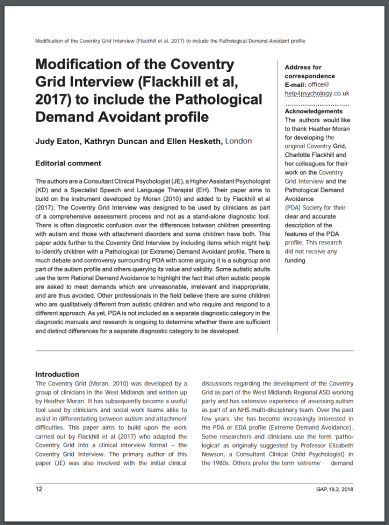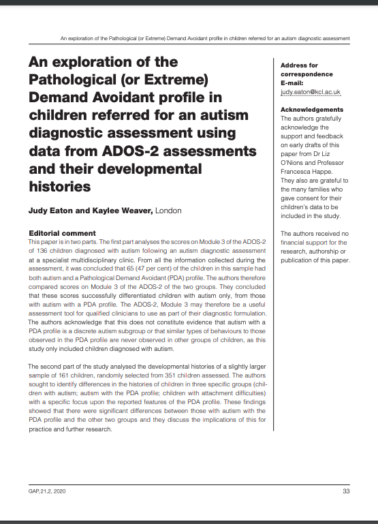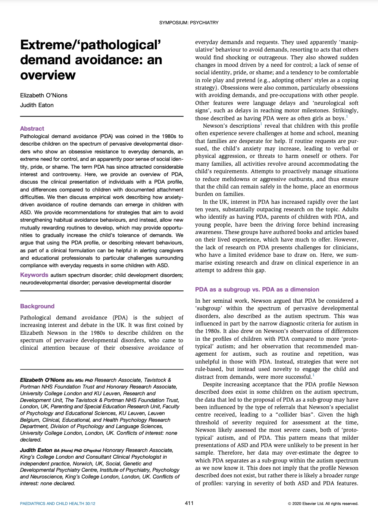We are currently in the process of producing a number of papers and journal articles following our in-
Further updates regarding this research will be published on this page as and when they are available, and announced on our Facebook page.
Ask yourself – could this person be autistic?
Drawing from a deeply personal and professional journey, this piece explores the critical and often life-threatening consequences of misunderstanding and misdiagnosing autism. The author’s path into clinical psychology was shaped by the tragic loss of her own son, whose late-diagnosed autism and ADHD were consistently overlooked. Her career, spanning from early NHS autism assessment teams to secure inpatient services, revealed a stark reality: the “accepted narrative” of autism, predominantly focused on males, was leading to the systemic failure of girls and women. They were frequently mislabelled with stigmatising personality disorders, subjected to inappropriate medication, and placed in environments that exacerbated their distress. The author argues that this failure to recognise diverse autistic presentations extends to other marginalised groups, including men in the prison system and individuals from BAME backgrounds. Ultimately, it is a powerful plea for clinicians to discard outdated stereotypes and consider autism in all its forms, a practice that could save lives.
Modification of the Coventry Grid Interview (Flackhill et al, 2017) to include the Pathological Demand Avoidant profile
by Dr Judy Eaton, Kathryn Duncan and Ellen Hesketh
London
The authors are a Consultant Clinical Psychologist (JE), a Higher Assistant Psychologist (KD) and a Specialist Speech and Language Therapist (EH). Their paper aims to build on the instrument developed by Moran (2010) and added to by Flackhill et al (2017). The Coventry Grid Interview was designed to be used by clinicians as part of a comprehensive assessment process and not as a stand-alone diagnostic tool. There is often diagnostic confusion over the differences between children presenting with autism and those with attachment disorders and some children have both. This paper adds further to the Coventry Grid Interview by including items which might help to identify children with a Pathological (or Extreme) Demand Avoidant profile. (To read the full journal please click the link below.)
An exploration of the Pathological (or Extreme) Demand Avoidant profile in children referred for an autism diagnostic assessment using data from ADOS-2 assessments and their developmental histories
by Dr Judy Eaton, Kaylee Weaver
London
This paper is in two parts. The first part analyses the scores on Module 3 of the ADOS-2 of 136 children diagnosed with autism following an autism diagnostic assessment at a specialist multidisciplinary clinic. From all the information collected during the assessment, it was concluded that 65 (47 per cent) of the children in this sample had both autism and a Pathological Demand Avoidant (PDA) profile. The authors therefore compared scores on Module 3 of the ADOS-2 of the two groups. They concluded that these scores successfully differentiated children with autism only, from those with autism with a PDA profile. The ADOS-2, Module 3 may therefore be a useful assessment tool for qualified clinicians to use as part of their diagnostic formulation. The authors acknowledge that this does not constitute evidence that autism with a PDA profile is a discrete autism subgroup or that similar types of behaviours to those observed in the PDA profile are never observed in other groups of children, as this study only included children diagnosed with autism.
The second part of the study analysed the developmental histories of a slightly larger sample of 161 children, randomly selected from 351 children assessed. The authors sought to identify differences in the histories of children in three specific groups (children with autism; autism with the PDA profile; children with attachment difficulties) with a specific focus upon the reported features of the PDA profile. These findings showed that there were significant differences between those with autism with the PDA profile and the other two groups and they discuss the implications of this for practice and further research.
Extreme/‘pathological’ demand avoidance: an overview
by Elizabeth O’Nions and Dr Judy Eaton
London
Pathological demand avoidance (PDA) was coined in the 1980s to describe children on the spectrum of pervasive developmental disorders who show an obsessive resistance to everyday demands, an extreme need for control, and an apparently poor sense of social identity, pride, or shame. The term PDA has since attracted considerable interest and controversy. Here, we provide an overview of PDA, discuss the clinical presentation of individuals with a PDA profile, and differences compared to children with documented attachment difficulties. We then discuss empirical work describing how anxiety-driven avoidance of routine demands can emerge in children with Autism We provide recommendations for strategies that aim to avoid strengthening habitual avoidance behaviours, and instead, allow new mutually rewarding routines to develop, which may provide opportunities to gradually increase the child’s tolerance of demands. We argue that using the PDA profile, or describing relevant behaviours, as part of a clinical formulation can be helpful in alerting caregivers and educational professionals to particular challenges surrounding compliance with everyday requests in some children with Autism.





